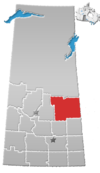Valparaiso | |
|---|---|
| Village of Valparaiso | |
| Coordinates: 52°30′21″N 104°06′18″W / 52.505964°N 104.104995°W | |
| Country | |
| Province | |
| Region | Central |
| Census division | 13 |
| Rural Municipality | Star City No. 428 |
| Government | |
| • Type | Municipal |
| • Governing body | Valparaiso Village Council |
| • Mayor | Margaret Emro |
| • Administrator | Ann Campbell |
| Area | |
| • Total | 0.69 km2 (0.27 sq mi) |
| Population (2016) | |
| • Total | 15 |
| • Density | 21.6/km2 (56/sq mi) |
| Time zone | UTC-6 (CST) |
| Postal code | S0E 1P0 |
| Area code | 306 |
| Highways | |
| Railways | Canadian National Railway |
| [1][2][3][4] | |
Valparaiso (2016 population: 15) is a village in the Canadian province of Saskatchewan within the Rural Municipality of Star City No. 428 and Census Division No. 14. The village is located at the junction of Highway 3 and Range Road No. 160, approximately 20 km east of the City of Melfort. The name comes from that of Valparaíso in Chile.[5]
History
[edit]Valparaiso incorporated as a village on July 18, 1924.[6]
Demographics
[edit]In the 2021 Census of Population conducted by Statistics Canada, Valparaiso had a population of 25 living in 11 of its 11 total private dwellings, a change of 66.7% from its 2016 population of 15. With a land area of 0.74 km2 (0.29 sq mi), it had a population density of 33.8/km2 (87.5/sq mi) in 2021.[9]
In the 2016 Census of Population, the Village of Valparaiso recorded a population of 15 living in 9 of its 11 total private dwellings, a 0% change from its 2011 population of 15. With a land area of 0.69 km2 (0.27 sq mi), it had a population density of 21.7/km2 (56.3/sq mi) in 2016.[10]
See also
[edit]References
[edit]- ^ National Archives, Archivia Net. "Post Offices and Postmasters".
- ^ Government of Saskatchewan, MRD Home. "Municipal Directory System". Archived from the original on November 21, 2008.
- ^ Canadian Textiles Institute. (2005). "CTI Determine your provincial constituency". Archived from the original on 2007-09-11.
- ^ Commissioner of Canada Elections, Chief Electoral Officer of Canada (2005). "Elections Canada On-line".
- ^ Rayburn, Alan (2001). Naming Canada: Stories about Canadian Place Names. University of Toronto Press. p. 117. ISBN 9780802047250.
- ^ "Urban Municipality Incorporations". Saskatchewan Ministry of Government Relations. Archived from the original on October 15, 2014. Retrieved June 1, 2020.
- ^ "Saskatchewan Census Population" (PDF). Saskatchewan Bureau of Statistics. Archived from the original (PDF) on September 24, 2015. Retrieved May 31, 2020.
- ^ "Saskatchewan Census Population". Saskatchewan Bureau of Statistics. Retrieved May 31, 2020.
- ^ "Population and dwelling counts: Canada, provinces and territories, census divisions and census subdivisions (municipalities), Saskatchewan". Statistics Canada. February 9, 2022. Retrieved April 1, 2022.
- ^ "Population and dwelling counts, for Canada, provinces and territories, and census subdivisions (municipalities), 2016 and 2011 censuses – 100% data (Saskatchewan)". Statistics Canada. February 8, 2017. Retrieved May 30, 2020.



Well, that’s interesting to know that Psilotum nudum are known as whisk ferns. Psilotum nudum is the commoner species of the two. While the P. flaccidum is a rare species and is found in the tropical islands. Both the species are usually epiphytic in habit and grow upon tree ferns. These species may also be terrestrial and grow in humus or in the crevices of the rocks.
View the detailed Guide of Psilotum nudum: Detailed Study Of Psilotum Nudum (Whisk Fern), Classification, Anatomy, Reproduction